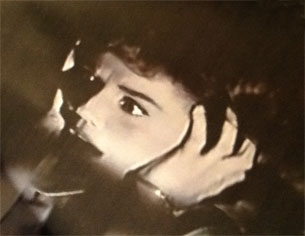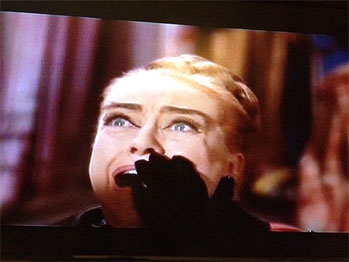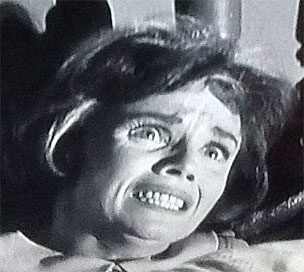by Peter Fraser with David Carson
Perhaps we all harbor a secret desire to test our metal against the most daunting forces of nature. How to satisfy that desire in the modern world is the challenge. The possibility of a Jack London-styled adventure has grown all the more exotic in our technology-driven society where common life avoids experience along the edges, and we are left to play out real adventure vicariously through television reality shows like Naked and Afraid, Survivor, Shipwrecked, and Lost. The producers of film profit from the latent desire as well, routinely placing viewers in danger zones within constructed, big-screen realities where that inner urge toward adventure can be satisfied by fictional characters overcoming the worry of Jurassic bugs, beasts and wasting diseases.

This social phenomenon may be part of the continuing appeal of the horror genre, which brought in over $1 billion in ticket sales in 2017. There are many who live lives of quiet desperation, as Thoreau put it, who sit quietly behind computer monitors eight hours a day just waiting for the evening or weekend release that will allow the viewing of the next Saw or Paranormal Activity sequel. Are these all closeted, bad people hiding repressed urges toward torture and murder? Probably not, or at least we hope not. For some of this group, it may just be that the allure of horror and the macabre provides the only escapist adventure they have. No sane person wants a thing pulling his covers off the bed at night, a feature of the profitable Paranormal Activity films, but perhaps watching it happen to a fictional character on the big screen stands in for the exotic experience missing in the typical grey cubicle.
This is one simple theory regarding the appeal and profit of the horror film. There are many others as this essay will go on to describe.
A similar man-in-the-street theory addresses the horror audience, reducing the genre to one targeting only certain types of people, those with personality-based predilections. On one end of the human spectrum is the extreme the thrill-seeker who when not skydiving or mountain-climbing obtains heightened testosterone and dopamine levels through watching someone cut in half with a chain saw. We all knew that kid in grade school who took pleasure in burning moths or boiling frogs. Unfortunately this theory limits the horror audience to a single personality category, and the numbers suggest there must be others sitting in the eerie darkness with them, harder to identify.
The experts have chimed in. Some psychologists contend that the cathartic feelings that often accompany horror viewings can bring into balance unprocessed emotions or complexes, either helping a person process such feelings or at least serving as a distraction from them. In such cases subjecting oneself to a chilling movie could actually serve as a refuge. This hypothesis follows Aristotelian logic; i.e., that the audience of a drama releases its own dread by the cathartic activity of participating in a ritual which a flawed character falls under the often judgment of the gods. There is something to that. After all, thousands came to the ancient Greek theater to take in the bloody catastrophes of Oedipus and Medea and Creon. Just replace those characters with a group of teenagers foolishly pursuing their license around Crystal Lake where Jason Voorhees awaits to avenge the death of his mother.
The most frequent theoretical approach to horror from the academic community is a variant of this ancient logic. In his seminal book American Nightmare (1979), Freudian critic Robin Wood made popular a line of horror film scholarship focused around a “return of the repressed” phenomenon. Looking at the human situation from a psychoanalytic perspective, it seemed plausible for Wood and his many disciples to conclude that horror monsters come from an individual’s repressed id, that portion of the psyche still connected to our evolved primal instincts, be they individualized as Freud saw them or universal as Jung claimed. Either way, the argument suggests that long-suppressed unconscious urges held in check by the socializing influences of the moral superego find ways to slip out once the psyche is jarred by some harrowing experience—shock, abuse, illness. So the repressed bestial side of the individual comes out in the context of these films as werewolf, predatory vampire, zombie, or raging beast from some ancient lagoon. The viewer struggling with his own raging beast finds the narrative arc cathartic because the impulse to let the thing out to prowl and feed is unconscious, buried in the dark caverns of the once primitive human brain.

Other scholars, less enamored with Freud’s view of the origins of evil, have suggested that some viewers may actually see the opportunity to grow and mature by experiencing vicarious terror, specifically in battle against fears and anxieties. Perhaps many of the millions watching these films might be classified as timid spectators hoping to know what it is to be bold. Studies have shown that some viewers have been struck with intense panic by the mere sight of horror film posters. Yet, they watch out of a deep and again unconscious desire to steel themselves against these negative emotions. Watch the whole movie, survive it from start to finish, and beat that masked bogey or clown. The thrill of success thus makes horror therapeutic, an inoculation. After all, despite the emotions, viewers are in a safe environment. The infamous tagline for the 1972 film The Last House on the Left was “It’s only a movie.” Anyone could at any point get up and leave the theater or now flip Netflix to The Great British Baking Show. Interviews after the fact will remind us that the blood and guts are fake, designed by talented artists and people just like us. Few of us would actually seek an encounter with a real-life demon-clown for sheer thrill. But exposing oneself to a setting with the constant reminder that “they are just actors; those are just special effects?”—it makes us strong.
The hero of the typical horror film must be victorious, of course, for this line of reasoning to hold, and since the 1970s the heroes have more often than not lost to the monster. Unlike a romance movie where the hero must win that girl before the big dance, horror heroes are simply thrust into scenarios of life or death, torture and damnation. When successful, overcoming the odds and the terrors that would petrify the average mortal provides a great exhilaration for the select viewer. Whew, she barely made it out of there! The rise and fall of adrenaline is so intense that the triumphs in horror film seem somehow greater than those of the superhero, romantic prince, or successful girl-next-door. But again, this theory only works when the hero survives or monster dies. And since the late 60s and 70s, the monster often wins in modern horror. Michael Myers keeps getting back up. And what happens then to the viewer when the film ends with the monster popping up from back seat of the hero’s car?
This same problem dogs another line of thought regarding the appeal of horror, that these films often place the viewer in an alluring position of power. Psychologist C. McCauley argued for Psychology Today that “the fictional nature of horror films affords viewers a sense of control by placing psychological distance between them and the violent acts they have witnessed.” Another critic suggests that this ability to distance oneself makes films about evil more enticing, for the viewer himself may “deny the desire to rebel against both heaven and the world’s natural balances, and thus hide their secret longing to see and experience, if only momentarily, the anarchy behind the wall hiding the domain of the devil.” One can claim he has no interest in evil and chaos in his world, and yet eagerly succumb to the enticement of watching them reign in a cinematic representation of that world. Horror allows the viewer to experience things that tantalize his curiosity – but from a safe and blameless environment. So, the viewer becomes complicit with the evil without becoming morally culpable.
These are just a few of the ways academic and cultural critics are explaining the popularity of the horror genre. Take each on its merits, but beware overlooking the most obvious aspect of the horror genre, which is the visualization of pure evil.
Horror films display evil. True, they also define that evil in differing ways, often reflecting current cultural anxieties. Over the past ten or so years, for example, one can see a trend in which horror films reflect the fears of a world 9/11, bird flu, or genetic experiments gone horribly wrong. The Cold War triggered movies like Godzilla and The Beast from 20,000 Fathoms, featuring the imaginative consequences of nuclear war. Invasion of the Body Snatchers and The Blob were stories about ubiquitous evil growing like a cancer over the country, think the fear of communism. Still, define the evil how you will, the films display a simple pattern—evil released and allowed to create mayhem on an unsuspecting populace. The stories visualize the hunt and kill.
Since the development of the scientific method during the 18th-century Enlightenment, scholars have been reticent to acknowledge the dogmas of the Church which hinge upon the non-observable concepts of mystery and faith. The modern state indoctrinates children in schools where the world is described only via observable terms, nothing more, and where the myth of progress, what C.S. Lewis termed our chronological snobbery, suggests that we are the ones who know unlike those religious or superstitious yokels of past ages. We have the means to see and control our environment.

Yet science cannot address the uncanny as the uncanny is an experience of the immaterial. And even the most modern of persons can recount some experience of the uncanny–the time you heard that voice or had that premonition or just knew to avoid that particular plane trip. Alongside the articles that come spilling our way celebrating the acquisition of new images of the cosmos viewed through impossibly powerful telescopes and new procedures for slicing open and fixing the body, we find accounts of more exorcisms performed than ever before, more encounters with ghosts or angels or heavenly voices, more people who died and came back wide-eyed. The twentieth century which witnessed a man take one great step onto the moon is the same century that saw three Portuguese shepherds at Fatima direct a crowd of over 40,000 witnesses to the Miracle of the Sun.
Bottom line is that science purports to answer all key questions but has left even more while bullying ordinary people prone to night terrors and eerie sensations into the forced confession that such things cannot be supernatural. But when the bully is out of sight, people think what they think.
The “what ifs” of disease-related zombie outbreaks on film or television or some surprise alien invasion have become our closet conversations. We whisper these questions about “other possibilities” through fictions, and the horror genre has become one place for the banished conversation. Put it simply—in an age bent on dismissing what science cannot verify, we find ourselves drawn toward the occult as rebellion. Why? Because our lived experience incline us against what the modern age proposes, that we are just a random pattern of evolutionary chance. Deep down we all know that life is Mysterious.
An older age once asserted that there are forces out there we cannot see but which would collapse us in dread if we did. Older horror forms, like 19th-century Gothic novels, described the forbidden realm in an attempt to conjure and then exorcise. The werewolf was let out to be shot by a sanctified, silver bullet. The vampire was let out to be stopped by the cross and then killed with a stake through the heart. Older horror films were a dangerous game, but akin to slaughtering a bull or goat to expiate our sins. More recent horror films made in an age no longer allowed to believe dispense with the ruse of the expiatory ritual. Evil is now simply let out to roam.
The well of horror will not run dry any time soon. Alfred Hitchcock once offered this unsettling prophesy: “Someday we won’t even have to make a movie — there’ll be electrodes implanted in their brains, as we’ll just press different buttons and they’ll go ‘oooh’ and ‘aaah’ and we’ll frighten them, and make them laugh. Won’t that be wonderful?” With the incorporation of altered and virtual reality, and the subsequent blurring of reality and fiction, we may very well be only a few years away from a more intense experience of the senses, and an entertainment too bad to avoid. Add to that an internet full of purported encounters and sights, and with video evidence. One day through the magic of film, we may be allowed virtual participation in the dark side of an exorcism.
Now that would really be something.
